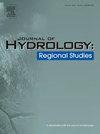Hydrologic pathways and nutrient loading in the headwaters of the Western Lake Erie Basin
IF 4.7
2区 地球科学
Q1 WATER RESOURCES
引用次数: 0
Abstract
Study region
Western Lake Erie Basin (WLEB). The WLEB is a flat, artificially drained, and intensively managed agricultural region typical of the U.S. Midwest.
Study focus
The study objective was to quantify hydrologic pathways using tracer-based hydrograph separation in a headwater watershed (19 km2) of the WLEB and assess relationships between water sources and fluxes and nutrient delivery. High-frequency measurement of two tracers (oxygen-18, δ18O; electrical conductivity, EC) along with discharge and nutrient concentration (nitrogen, N; phosphorus, P) was conducted at the watershed outlet (2017–2020).
New hydrological insights for the region
Results provide new insights into hydrologic and nutrient transport processes in artificially drained agricultural watersheds. Findings showed that 76 % discharge occurred during the winter and spring due to a threshold relationship with precipitation and soil moisture deficit. Hydrograph separation using δ18O and EC provided similar estimates of event water (26 ± 13 % and 26 ± 11 %, respectively), but substantial differences (up to 21 %) were observed between tracers for individual storms. Annually, event water comprised 13–27 % of discharge. Nutrient loads during storm events were strongly correlated to discharge, as flow-weighted mean concentrations (FWMCs) were consistent among storms and seasons. Both dissolved reactive P and ammonium-N FWMC were correlated to water sources. Findings suggest that decreasing discharge, decreasing the nutrient supply, and enhancing nutrient removal within ditch networks are needed to decrease nutrient loading drained watersheds in the WLEB.
求助全文
约1分钟内获得全文
求助全文
来源期刊

Journal of Hydrology-Regional Studies
Earth and Planetary Sciences-Earth and Planetary Sciences (miscellaneous)
CiteScore
6.70
自引率
8.50%
发文量
284
审稿时长
60 days
期刊介绍:
Journal of Hydrology: Regional Studies publishes original research papers enhancing the science of hydrology and aiming at region-specific problems, past and future conditions, analysis, review and solutions. The journal particularly welcomes research papers that deliver new insights into region-specific hydrological processes and responses to changing conditions, as well as contributions that incorporate interdisciplinarity and translational science.
 求助内容:
求助内容: 应助结果提醒方式:
应助结果提醒方式:


